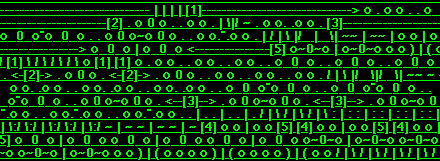
we love your computer

TEXT="#000000" LINK='#000000" VLINK="#00ff00" ALINK="#000000" onLoad="#setbackground();"> $I&^$&^&^$^**^
jh: I don't think you really avoid the art world by exhibiting art on the Internet. We were already working with computers, and I believe that the best way to view works made with a computer is to keep them in the computer. The Internet happens to be a very good system to spread this kind of work... % A HREF'"../day66/index.html" target="_top">XXXXXXXXXXXXX    onClick="return confirm( /font /tr> Wed Nov 05 15:01:46 1997 dp: The computer is not only a tool to create art but also the medium for showing it within the network. And since the network doesn't come with any established labels and systems of categorization yet, what little Stevie is doing maybe considered art. The same is true for our work: it's not labelled art. In the medium, in which our work is usually seen, viewers don't necessarily care about labels. But if our work is shown in a gallery space or at the documenta, it comes with the label "art," which means that we have to find "art ways" to exhibit our work. ia: How do you feel about the way your material was shown at the documenta? dp: In Kassel, the interface used for showing net art is an office space. I think this metaphor is too much of a clichee. It's meant to be some kind of joke, but it's not funny--it's vulgar, it's too easy. It doesn't work. And now this form of representation will be repeated over and over again. The same thing happened in the early years of video. When video developed out of a critique of television, experiments with video art were shown on local American TV stations. Early Nam June Paik tapes were produced by U.S. cable stations. When showing the work, museums or galleries swould set up little living rooms where visitors could watch the tapes. They thought: "It's TV, we can't present it just with the U-Matic player next to the television set, we need a home decor." ia: So what would be the alternative to the way net art was presented at documenta? Should it just be left it on the Net?  dp: I personally think that if you have a physical space to show net art, you have an opportunity to present it to people who are not used to computers. And you could also give the artists the option to add on to their installations. I believe it is very important for net artists to get involved in the presentation of their work, or they will be re-presented by other people; for example, by designers who are asked to create an environment that meets the specifics of a particular exhibition space. That's the worst. The different works disappear in the set-up conceived by the one person who deals with the real space, which becomes more powerful than all the networks. After all, you are in the real space when viewing the works. If all you're responsible for is the presentation of your work on the Net, you become a fragment of the local situation and you can easily become be manipulated. ia: Were you approached by the organizers of the documenta regarding the presentation of your work in the show? jh: No. At first we heard that the net art works would be upstairs in the documenta Halle (the exhibition space "documenta hall"). This plan was changed 10 days before the opening. Finally, the net art was shown in a room behind the cafe downstairs, and some designers painted the walls blue and build strange furniture. The artists were never contacted. dp: Other artists also didn't like the way the Internet room was cornered, next to the cafe, the bookstore and the lecture hall. This set-up gave the impression of one gigantic recreation area. You had to be really curious about Net art in order to enter this cave. The room was not inviting, it looked like an IBM show room. We talked to many people standing near the entrance. When they saw the set-up, they said: that's not for us, that's some computer world. jh: In reality, we don't work out of an office. Many people have their computers set up next to their beds. Twenty years ago, it was maybe true that computers were only found in offices. Now it is fairly common that computers sit on the dinner table. An office space creates a distance. I don't like to be in an office.  ia: I understand that you had to remove certain links from your work to present it at documenta. dp: We created a map of the Internet: we took a diagram of all the big back-bones and the names of the major providers and replaced the names of technical providers with alternative sites and art sites on the Net, and created links. We put this piece on the documenta site. Every time a vistor to the documenta Halle tried to click on one of the links on the map, the computer crashed. ia: Do you think that this form of presentation has negative repercussions on how your work is perceived? dp: No. We left the link page in the work, even though it would have been wiser to take it out. But at least we didn't make any concessions to the documenta, which feels good. It wasn't easy to get a a good impression of our site but that was the case with other pieces as well. If you really want to explore the works, you need a connection to the Net. In a way, their representation in Kassel was only symbolic.  ia: But if your work consists only of one page with links to other sites, in what sense is it net-specific? Couldn't it also be presented on a CD-ROM? jh: The Internet is the enviroment where it belonmgs. Our work plays with the speed of transmission over the Internet, or rather with the slowness of transmission. That aspect would get lost, if the work were presented on a CD-ROM. To make the work more accessible, all of the pages at our site are 30 kilobytes or less. Yet we think: the slower, the better. CD-ROM is a static medium and we change our site a lot. We probably made about 150 changes on our site since we first set it up. ia: Do you also have to update your work when new browsers come out? jh: Not really. We once had a problem when Netscape 3.0 came out. We used these background layers that kept flipping back and forth under Netscape 2.0, and that didn't work with the new browser. dp: Fear isn't a good basis for work. We have no fear. We do this type of work because because we're angry. People perceive this anger when they are on the other end, at the receiving computer... ia: Where does your anger come from? dp: The seriousness of technology. It is obvious that our work is directed against high tech. We also battle with the computer on the level of graphics. The computer presents itself as a desktop, with a trash can on the right and pull-down menues and all the system icons. We explore the computer from inside, and mirror this on the Net. When viewers look at our work, we are inside their computer. There is this hacker slogan: "We love your computer." Like hackers, we get inside people's computers. And we are honored to be inside somebody's computer. You are very close to people when you are on their desktop. I think the computer is a device to get into someone's mind. We counter this mythological notion of a virtual society on the Net with a more personal approach. We put our own personalities on-line. |
ia: My impression is that a lot of people briefly look at your site and then--without ever exploring the details--they go elsewhere thinking, "Oh, there is this site that looks like your computer is broken," and then it's back to CNN or Yahoo. Does that bother you? dp: No. Media art always exists on the surface. You have to capture people's attention very quickly. You need to give them a karate punch as soon as possible. Otherwise, they don't get to the details, and the site will just sit there for the next five or ten years, or maybe100 years. And maybe their children will have the time to explore the details... (laughs) ia: Do you trace how people move through your site? dp: We once had a counter installed, but we lost track of the numbers. We were checking it every day, and it became anobsession. It was ridiculous: "Oh, only 50 people today." And then we checked again an hour later: "Oh, now it's 65 people!" We don't have a counter installed anymore. Most net artists, though, log everything that happens on their sites. Not that they make use of it, but the artist's egos want to know how the public looks at their works. ia: What kind of reactions do you get from your audience? dp: We get a lot of e-mail. In the first few weeks after we put up the site we got many complaints. People were seriously thinking that we had made mistakes and then wanted to teach us. They sent us e-mail saying: "You have to put this tag in front of this code." Or: "I'm sorry to tell you that you forgot this command on your page." The first page of our site, for example, is in unformatted ASCII. We discovered by accident that it looked very good. But we keep getting complaints about this. ia: But you don't just get complaints? dp: No, sometimes people send us helpful code. Somebody once sent us a java applet that we actually used for our site. We are really grateful for that. Some people really encourage us, too. They say: "Go, Jodi, go. Make more chaos. Make my computer crash more often." ia: At your site, there is no hint as to who is behind it: is it a company? Is it an organization? Is it a gang? Is it a comment on anonymity on the Internet? dp: We decided to put the work on the screen without press releases or bios. We don't use our site to present information. We present screens and things that are happening on these screens. We avoid explanations. Take a look at any exhibition: People are sniffing out the information plates next to the art work before they look at the art itself. They want to know who create a piece before they voice an opinion about it. We try to avoid getting caught in that system.
ia: At this point, you have only dematerialized objects on your server, nothing that could be sold. What is your "business model" as artists? dp: We haven't given too much thought to this question but there is always the so-called "service fee" that you can ask for as an artist if you do a workshop or give a talk. ia: What did you get for the participation in the documenta? dp: We got a fee for the expenses we incurred when we put our files on their server. In total we received approximately $ 700. It is a clear example of exploitation. Which artist would move his ass for this amount of money? But net art is a victim of its B-status. It is treated as a group phenomenon, a technically defined new art form. This is something we have to leave behind as soon as possible because the standard way of doing things is this: a group hypes something up, calling it mail art or video art, and it's doomed to die within five years. We are looking for another way to work--we are not typical artists and we also won't play the role of the net artists forever. |